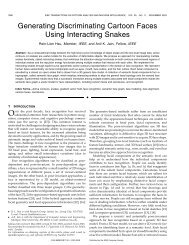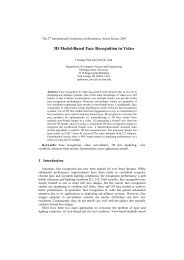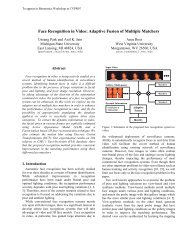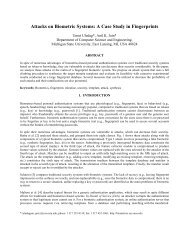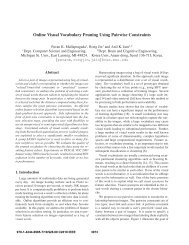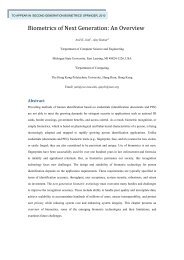Face Detection and Modeling for Recognition - Biometrics Research ...
Face Detection and Modeling for Recognition - Biometrics Research ...
Face Detection and Modeling for Recognition - Biometrics Research ...
Create successful ePaper yourself
Turn your PDF publications into a flip-book with our unique Google optimized e-Paper software.
perimental results demonstrate successful detection of faces with different sizes, color,<br />
position, scale, orientation, 3D pose, <strong>and</strong> expression in several photo collections.<br />
3D human face models augment the appearance-based face recognition approaches<br />
to assist face recognition under the illumination <strong>and</strong> head pose variations. For the two<br />
proposed recognition paradigms, we have designed two methods <strong>for</strong> modeling human<br />
faces based on (i) a generic 3D face model <strong>and</strong> an individual’s facial measurements of<br />
shape <strong>and</strong> texture captured in the frontal view, <strong>and</strong> (ii) alignment of a semantic face<br />
graph, derived from a generic 3D face model, onto a frontal face image. Our modeling<br />
methods adapt recognition-oriented facial features of a generic model to those<br />
extracted from facial measurements in a global-to-local fashion. The first modeling<br />
method uses displacement propagation <strong>and</strong> 2.5D snakes <strong>for</strong> model alignment. The<br />
resulting 3D face model is visually similar to the true face, <strong>and</strong> proves to be quite<br />
useful <strong>for</strong> recognizing non-frontal views based on an appearance-based recognition<br />
algorithm. The second modeling method uses interacting snakes <strong>for</strong> graph alignment.<br />
A successful interaction of snakes (associated with eyes, mouth, nose, etc.) results in<br />
appropriate component weights based on distinctiveness <strong>and</strong> visibility of individual<br />
facial components. After alignment, facial components are trans<strong>for</strong>med to a feature<br />
space <strong>and</strong> weighted <strong>for</strong> semantic face matching. The semantic face graph facilitates<br />
face matching based on selected components, <strong>and</strong> effective 3D model updating based<br />
on 2D images. The results of face matching demonstrate that the proposed model<br />
can lead to classification <strong>and</strong> visualization (e.g., the generation of cartoon faces <strong>and</strong><br />
facial caricatures) of human faces using the derived semantic face graphs.



